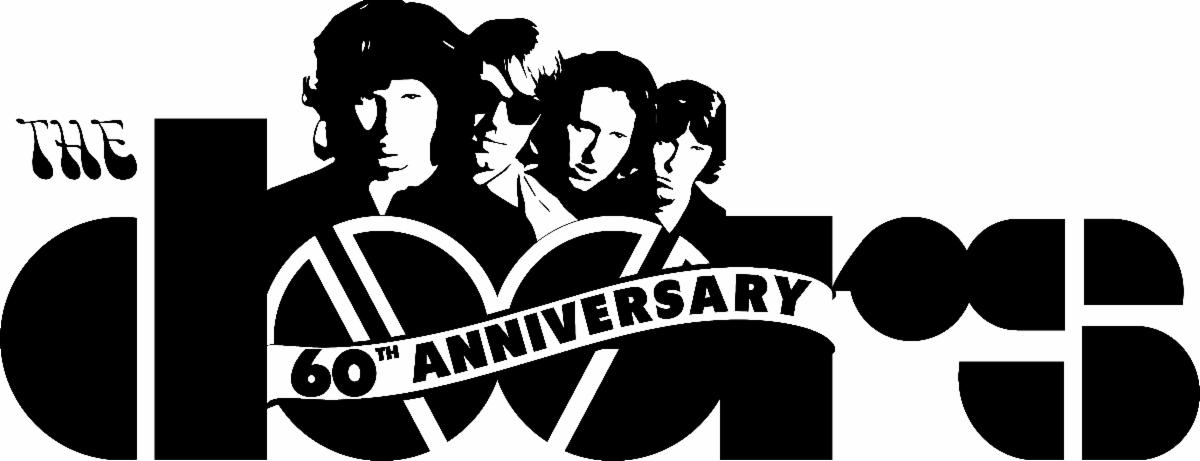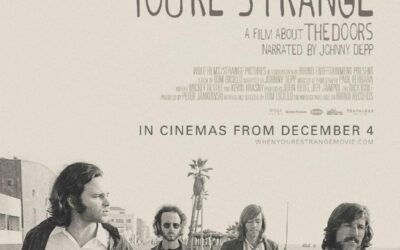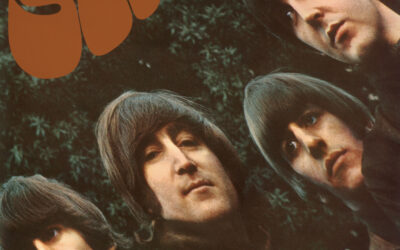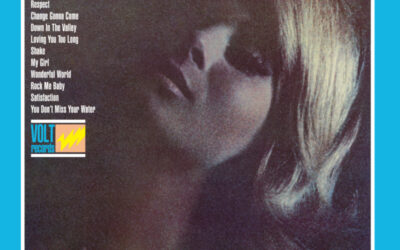In November 2024, the Doors kicked off the 2025 60th Anniversary with a new anniversary logo, a series of physical releases, and anthology book, and much more to be announced in the future.
The Doors 1967-1971 6-LP set arrived as the latest installment in Rhino’s acclaimed High Fidelity audiophile vinyl series on November 22, 2024, featuring all six of the band’s original studio albums cut from the original analog master tapes by Kevin Gray at Cohearant Audio.
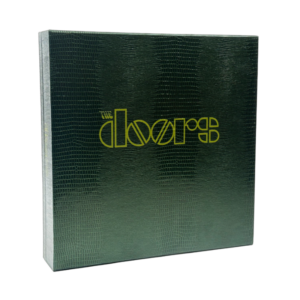
Green box set image courtesy Rhino
The vinyl was pressed at Optimal Media and the box includes a heavyweight gatefold jacket featuring rare photos and liner notes by Doors’ archivist David Dutkowski. Only 3,000 copies of the limited-edition set are available exclusively at thedoors.com and rhino.com.
The Doors delivered six studio albums before Jim Morrison’s untimely death in Paris in 1971. They remain one of the best-selling bands of all time with over 100 million records sold worldwide.
Created to commemorate the upcoming 60th anniversary, the Doors’ first-ever complete anthology book Night Divides the Day from Genesis will illuminate the band’s archives like never before with rare photography, intimate interviews with Robby Krieger and John Densmore, and meticulously sourced archival text from Jim Morrison and Ray Manzarek. Night Divides the Day is scheduled for April publication, includes historical ephemera – including childhood photos, song lyrics, poster artwork, movie stills, and much more – which adds context to the wealth of rare photography that documents the band’s musical odyssey.
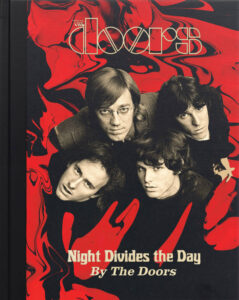
Book cover image courtesy Genesis Publishing
Joining Robby and John are a host of contributors, with a foreword by Nirvana bassist Krist Novoselic, and afterword by maestro Gustavo Dudamel. The anthology is presented in a limited-edition of only 2,000 numbered box sets, each hand-signed by Densmore and Krieger. Each set includes the 344-page signed edition, a 7” vinyl record with rare demos of “Hello, I Love You” and “Moonlight Drive,” and other assorted historical memorabilia.
I went to a concert by the Doors at the Fabulous Forum in Inglewood, California, on December 14, 1968.
On the bill were Jerry Lee Lewis, Sweetwater, and Tzon Yen Luie, who performed on a Chinese stringed instrument, the pipa. I’m still recovering from the Doors riveting “Celebration of the Lizard,” and string and brass section with Curtis Amy on stage.
In 1973 I coordinated two accredited upper-division English and music curriculum courses conducted by Dr. James L. Wheeler, assistant professor in the School of Literature at California State University, San Diego.
A story in the April 14, 1973 Billboard magazine reported the department’s academic aim as “the world’s first university level rock studies program.” I placed Jim Morrison’s The Lords and the New Creatures on the required book list.
Ray Manzarek heard about our classes and was very complimentary about students seriously studying Jim as a poet, along with catalogues of Jimi Hendrix, Smokey Robinson, Bob Dylan, the Rolling Stones, the Impressions’ Curtis Mayfield & the Impressions, Leonard Cohen, The Band, Jefferson Airplane, the Beatles, Donovan, and Laura Nyro.
One evening, Ray and Doors’ associate Danny Sugerman made arrangements for me to screen the existing print of Jim Morrison’s Feast of Friends movie on campus.
I met Ray Manzarek in 1974 and interviewed him at Mercury Records on Hollywood Boulevard. I conducted over a dozen interviews with him.
Danny in 1978 was a guest on my television program 50/50, promoting his just-published book with Jerry Hopkins, No One Here Gets Out Alive, the first biography of Jim Morrison. Our interview was the prototype EPK (Electronic Press Kit) by Warner Books advancing Sugerman’s book tour. Record producer Michael Lloyd, musician/songwriter Todd Rundgren and deejay Murray the K were guests on other episodes. During 1978, Cynthia Kirk in Variety interviewed me, and later reviewed 50/50, writing, “50/50 was on a par with The Midnight Special.”
In the mid-eighties, Ray Manzarek played piano and organ on albums I produced and at shows I presented.
During July 1995 in East Hollywood at the MET Theatre on Oxford Avenue, I produced and co-curated with director Darrell Larson, and associate producer Daniel Weizmann, a month-long Rock and Roll in Literature series.
Manzarek, Densmore and Krieger reunited and played “Peace Frog,” “Love Me Two Times” and “Little Red Rooster” on July 8th. Journalist Kirk Silsbee read from Art Pepper’s Straight Life, John Densmore from his novel, and actor Michael Ontkean recited Ode to L.A. by Jim Morrison.
Ray penned the Foreword to my 2009 book Canyon of Dreams: The Magic and the Music of Laurel Canyon.
In 2007 I interviewed John Densmore for MOJO magazine. He explained his various back beat roles in the Doors.
“Jim had an astounding baritone. Un-schooled. Never got nodes like Grace Slick and had to have surgery. God, if you don’t have that bottom… It was luck. It was fate. He never sang before I saw him in the garage. It was kind of squeaky in the early days. He just was afraid to open up. How audacious. ‘OK. I’ve never sung and I’m gonna be the lead singer of a rock band.’
“I had to work harder on the tempo because Ray’s left hand was the bass. And when he took a solo, he’d get excited and speed up. ‘Hold it back. Hold it back.’ But, without a separate guy doing bass line runs and grooves there are holes. ‘OK. I’m going in.’ Sometimes I didn’t do anything. That was my territory between the beats.
“During band rehearsals or just before we recorded, mainly I heard Jim’s words live and by himself in the garage, or Ray would hand me a slip of paper and they were pulsating rhythms of words. Because Jim was a poet they were edited. Like, ‘Break on Through’ was so percussive. When we were recording and locked in, I was in it. We were just so in it. We were lost. Playing live there were big sections on ‘The End’ or ‘When the Music’s Over,’ when we would vamp, and Jim would throw in anything. And then, ‘Oh yeah? I’ll throw that back at you. Check this out.’ ‘The End’ was a raga tune.”
One key ingredient the Doors’ audio stew is the jazz influence John brought to the Doors. Cream, the Rolling Stones, and the Jimi Hendrix Experience all had jazz drummers now playing rock ‘n’ roll.
“Ginger Baker was in a trio with a lot of poly rhythm shit goin’ on. Like Elvin [Jones]. Charlie Watts’ feel. He had the pocket.
“He got it from hearing all those jazz guys like Stan Levey and Chico Hamilton. I saw Chico at the Lighthouse [club] and stole one of his cymbal things that I used in ‘The End.’ Mitch Mitchell’s hands are really fast. More than Keith Moon. And, Mitch is fluid as hell.
“Chico Hamilton. There was this ride cymbal riff that Chico did on a song. Really the ride cymbal on ‘The End’ once I get to the kit and I’m playing the tambourine, it’s Chico Hamilton. That’s where it came from. Chico was direct. ‘Oh, that kind of cool cymbal riff I think would fit in that song.’ I was thinking to myself. Like, going into the bridge on ‘Wild Child,’ that’s the press roll from Art Blakey. That was the direct influence of the record labels Pacific Jazz and World Pacific.
“We wrote the first two Doors’ albums before we made any records. Robby and I are in the Lookout Mountain house, a block down from Appian Way, and that’s where Jim walked up and wrote ‘People Are Strange’ on a matchbook.
‘“Love Street’ is about the Laurel Canyon Country store. I love the melody. I thought it should have been a single and I know it’s kind of light to the dark Doors, but I just love the melody. Melody is paramount for me. I’m a drummer.
“I wasn’t thinking cinematic, but certainly Ray and Jim coming out of the UCLA School of Film were cinematic dudes. That’s for sure. I mean, I hear the world. Filmmakers see it.”
In 2010 Ray Manzarek mentioned the impact a film class had on him while attending the UCLA School of Film with director Josef Von Sternberg (The Blue Angel, Morocco, Shanghai Express).
“He saw my student film Evergreen and came up to me after and said, ‘Very good Manzarek. Very good.’ One of the greatest moments of my life. And Jim had him too. So, he’s the guy who really kind of gave a real sense of darkness to the Doors, not that we wouldn’t have been there anyway. But having Von Sternberg seeing the deep psychology of his movies, and the pace at which he paced his films, really influenced the Doors’ music. The sheer psychological weight of his movies on what we tried to do with our music.
“The film school is always there. Our song structure was based on the cinema. Loud. Soft. Gentle. Violent. A Doors’ song is oral and aural cinema. We always tried to make pictures in your mind. Your mind ear. You hear pictures with the music itself.”
Manzarek reiterated Jim Morrison did not quit the UCLA film school, either, as depicted in director Oliver Stone’s biopic The Doors.
“He graduated. Jim’s parents wouldn’t have paid the rent on his Goshen Avenue Westwood apartment without that UCLA degree!”
(Harvey Kubernik is the author of 20 books, including 2009’s Canyon Of Dreams: The Magic And The Music Of Laurel Canyon, 2014’s Turn Up The Radio! Rock, Pop and Roll In Los Angeles 1956-1972, 2015’s Every Body Knows: Leonard Cohen, 2016’s Heart of Gold Neil Young and 2017’s 1967: A Complete Rock Music History of the Summer of Love.
Sterling/Barnes and Noble in 2018 published Harvey and Kenneth Kubernik’s The Story Of The Band: From Big Pink To The Last Waltz. In 2021 the duo wrote Jimi Hendrix: Voodoo Child for Sterling/Barnes and Noble.
Otherworld Cottage Industries in 2020 published Harvey’s Docs That Rock, Music That Matters. His next book due in 2025 is Screen Gems: (Pop Music Documentaries and Rock ‘n’ Roll Television Moments).
During 2006 Harvey spoke at the special hearings by The Library of Congress in Hollywood, California, discussing archiving practices and audiotape preservation. In 2017 Kubernik appeared at the Rock and Roll Hall of Fame in Cleveland, Ohio, in their Distinguished Speakers Series).

